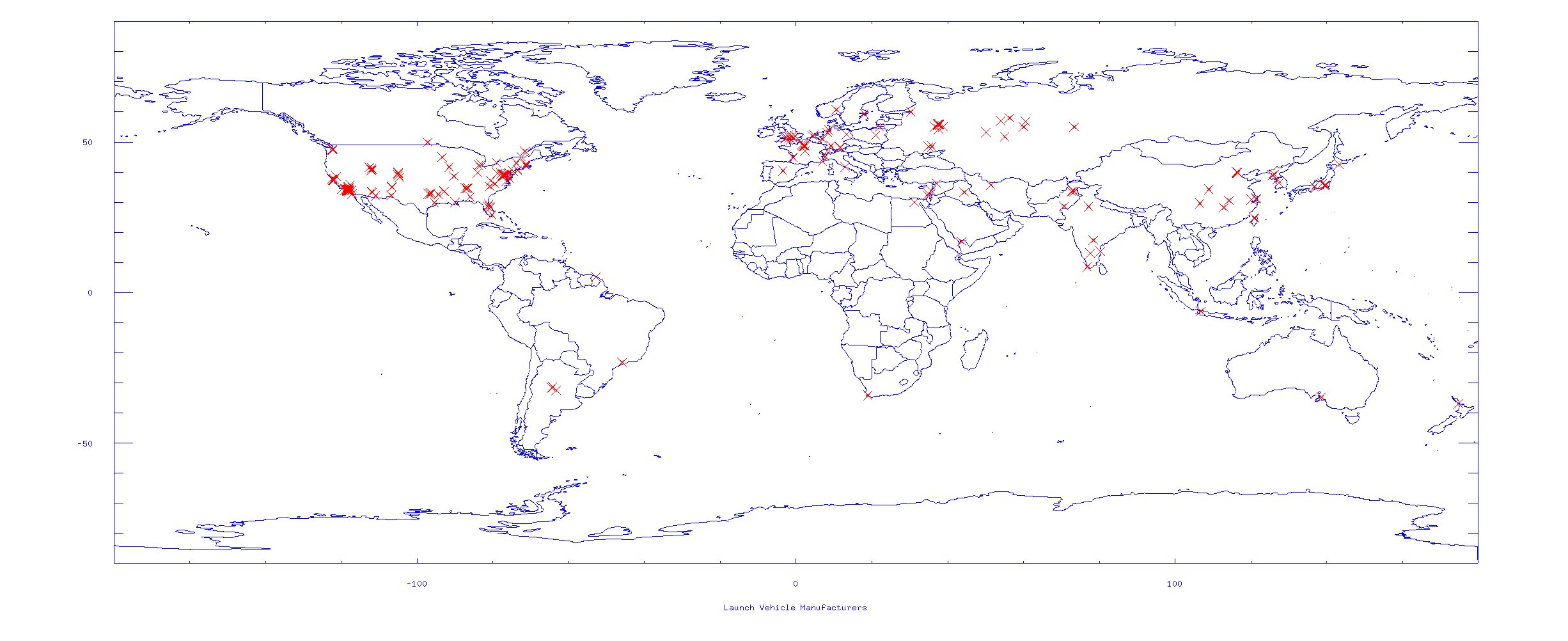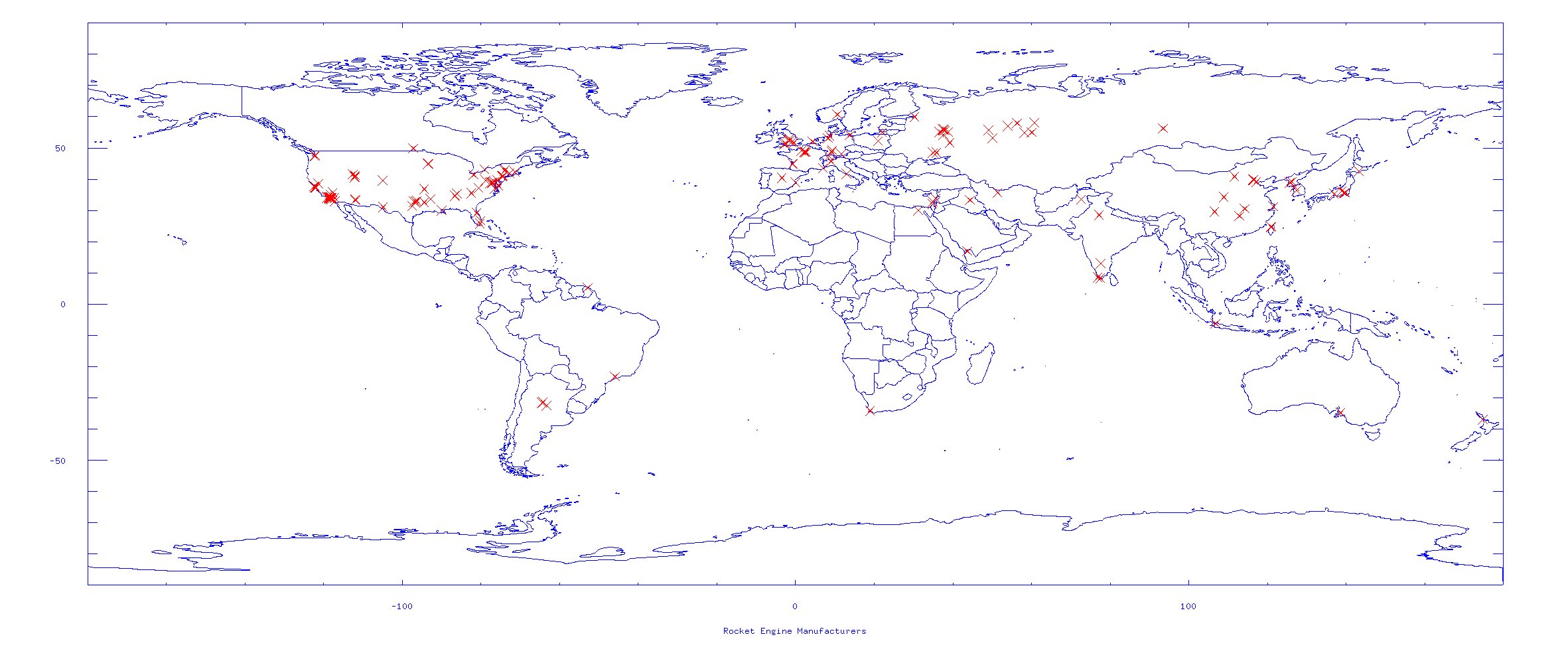The Space Organizations Catalog
GCAT Release 1.8.0 (2025 Nov 10) | Data Update 2026 Jan 5Introduction
In catalogs, review papers and databases describing or
tabulating artificial satellites, space launches and other astronautical
events, it is often necessary or useful to report the country of origin,
owner organization, and/or manufacturer of the object
of interest. This can be problematic as there is no standard way
to refer to a particular organization. Organizations or parts
of organizations are frequently sold, merge, or otherwise change their names,
potentially concealing continuity in design of their spacecraft.
For my purposes, an `organization' can be any named and spacetime-localized entity including
- A world or a region on a world - an 'astronomical polity' (AP)
- A country (nation-state) or autonomous political region (CY)
- An intergovernmental or supranational organization, used as if it were a country (IGO)
- An academic (A) or non-profit organization
- A business (B) entity, a corporation, company, or operating location thereof
- A civilian (C) or military/defense (D) government agency, base, or group
In this paper I present a scheme - the `Org Code' - for referring to
space organizations and a database of such organizations. The scheme and associated
database
were developed to
address this problem for the General Catalog of Artifical Space Objects (GCASO,
McDowell 2020 in prep.), but I hope it will be found generally useful
as no other comparable public dataset exists.
The organizations database generally includes only owner/operator
and prime contractors for already-launched spacecraft, stages, stage
main propulsion engines, etc., not subsystem level contractors, data
analysis organizations, nor (with some exceptions) organizations
involved only in missions whose launch is not yet imminent.
Although most documents describe satellite ownership and manufacture
at the level of a headquarters parent agency or corporation (NASA, Boeing,
Roskosmos, JAXA), I find it more illuminating to follow events at the level
of a single operating location - an agency center like NASA-Goddard, or
a factory/design organization like McDonnell Douglas/Huntingdon Beach (now
Boeing). I assign a short alphanumeric code, the Org Code, to
each such operating location.
Below: map showing geographic distribution of all organizations in the database
(click for larger version)
The Org Code
Allowed characters
The GCASO Org Code scheme presented here uses a unique string of 1 to 8 characters to refer to an organization. Allowed characters are the digits 0-9, the ASCII upper case letters A to Z, and the dash (minus-sign). Some examples of the Org Code are: I-ESRO, SWRIB, B, 44FA2, IQ223, NASA.Code and UCode: Organization phases
We want to track the time evolution of an organization as it changes outward identity at the same location. Each change marks the start of a new 'phase' which gets a new Org Code, but also has an associated `` UCode '' (unified code) which is the same for all of the phases (and is usually, but not necessarily, the Org Code of the first phase). Note that each UCode is itself an Org Code.
For example, let us consider the Palo Alto, California
location of Ford Aerospace. I assign this the UCode FORDA,
with a series of phases:
| Code | UCode | Name | Dates |
|---|---|---|---|
| PHLP | FORDA | Philco Western Development Labs (WDL) | 1957-1966 |
| PHFP | FORDA | Philco-Ford WDL | 1966-1975 |
| FORDP | FORDA | Aeronutronic Ford, WDL | 1975 - 1976 Dec |
| FORDA | FORDA | Ford Aerospace/Palo Alto | 1976 Dec - 1990 Oct |
| LOR | FORD | Space Systems Loral | 1990 Oct - 2012 Nov |
| SSL | FORDA | MDA-SSL | 2012 Nov - 2017 Oct |
| SSLMAX | FORDA | Maxar SSL | 2017 Oct -2019 Mar |
| MAXSS | FORDA | Maxar Space Solutions | 2019 Mar - present |
In the organization database each code is paired with a UCode, so that
all the codes with a common UCode can be identified. This allows
us to understand that there is a historical connection between satellites
built by SSL and those whose manufacturer was PHFP.
So, all the 1300 series communications satellites were built by (Ucode) FORDA,
but each one can also be tagged with the specific name of the company as it existed
at the time of the satellite's launch.
Note that countries can have phases too - the Czech republic is CSSR
(1940-1990), CSFR (1990-1993) and CZ (1993-present), sharing the ucode
CZ. Note that for countries extant in the early 21st century, the ucode
is usually the Internet TLD, e.g. CN like .cn for Zhongguo (China),
although the usual single-letter abbreviations have been used for
European Union countries e.g. D for Deutschland (Germany), F for France
etc. Most two-letter ucodes are countries but there are a few exceptions
(LM for Lockheed Martin, for example).
The Database
The database consists of a single table in which each record is an organizational phase with its Org Code. The columns are:
| Column Name | Description |
|---|---|
| Code | Org Code for organization in a particular phase (time period) |
| UCode | `unified' Org Code for organization across all time periods |
| StateCode | OrgCode for organzation's host state. |
| Type | Organization roles: a slash-separated set of types. |
| Class | Organization class: A, B, C, or D (Nonprofit, commercial, civil or defence) |
| TStart | Calendar date of phase start - e.g. when the org was founded |
| TStop | Calendar date of phase end - e.g. when the org was closed or renamed |
| ShortName | Short name of organization (ASCII, host language) |
| Name | Full name of organization (ASCII, host language) |
| Location | Approximate location (e.g. city) |
| Longitude | Longitude of location, deg E |
| Latitude | Latitude of location, deg N |
| Error | Error in lon/lat, deg |
| Parent | OrgCode of organization of which this org is a part |
| ShortEName | Short name of organization (ASCII, English) |
| EName | Full name of organization (ASCII, English) |
| UName | Full name of organization (Unicode, host language) |
The way these columns are used is explained in more detail in the following subsection.
First I present a diagram illustrating how the database entries relate the different organizations
to one another:
Column details
- Code - the Org Code for this organization/time phase.
- UCode - the unified Org Code for all phases for this organization.
- StateCode - Org Code for the nation-state, IGO or other polity with responsibility for the organization. This is normally the country in which the organization is located (referred to as 'host country' in the remainder of this document). Type of the state code must be CY, IGO or AP.
- Type - the organization type
This indicates the role of the organization, e.g. a payload operator, a launch agency, etc. The current database is somewhat patchy in data quality for this field, and I do not recommend relying on data in this column with the exception of the special values CY, IGO and AP which indicate entries with a status equivalent to a nation-state.
An entry can have multiple values of Type which are separated by a slash character, e.g. LV/E indicating the organization has both LV and E roles. Alternativley, an entry may have no Type value present at all.
Additional roles are reserved for the related Launch Sites database and are noted in the table below.
The full list of roles is:
Type code Meaning States and similar entities CY Country (i.e. nation-state or autonomous region). Not always the same as the ISO3166 code even when the latter exists. CYP Country province. Part of a nation-state or autonomous region. IGO Intergovernmental organization. Treated as equivalent to a country for the purposes of tabulations of launches by country etc. AP Astronomical Polity: e.g. Luna, Mars. Used for the 'country' field for locations that are not on Earth and therefore don't have a country. Manufacturers E Engine manufacturer LV Launch vehicle manufacturer W Meteorological rocket launch agency or manufacturer PL Payload manufacturer Operators LA Launch Agency S Suborbital payload operator O Payload owner P Parent organization of another entry Launch origin or destination LS Launch site LP Launch position LC Launch cruise LZ Launch zone TGT Suborbital target area
- Class - the organization class.
Each organization is tagged as one of:
- A (Academic, amateur and non-profit)
- B (Business/commercial)
- C (Civil government)
- D (Defense/military/intelligence)
The same classes are used in the satellite payload database to mark indvidual satellites - usually the class of the satellite is the same as the class of the owner organization, but not always. - TStart and
TStop
- start and stop time of this
organization phase. Given in year, month, day format
(actually
Vague Date format.
)
Null values are indicated by a dash. Null TStart means the start date of the organization is unknown; Null Stop means that the organization is still in operation, or assumed to be so. - ShortName - a short ASCII name of the organization suitable for use in labels or tables, nominally a transliterated representation of the name in the host country's own language (or one of its principal languages, as appropriate).
- Name - a full name (up to 80 ASCII characters). Transliterated full name of the organization, in host country's language.
- Location - City and locality of the organization. In many cases this is given in the form UrbanArea-Suburb, e.g "Los Angeles-El Segundo". The precise address is not currently included in the database, although admittedly this would have been desirable.
- Longitude,
Latitude, Error.
- The values are geographic longitude (east-positive) and latitude
in decimal degrees.
For the Organizations database the error field is not filled but is usually 0.1 deg. - Parent,
when nonempty, provides an Org Code of the
organization of which the current entry is a subset. Thus, NASA
is the parent of Goddard Space Flight Center.
Note that in a few cases, an Org is noted as having more than one parent (two Org Codes separated by a solidus, e.g. MOTI/TMI). In these cases the Org is an equal joint venture of the two parents. However in practice in my software I ignore the second parent. - ShortEName - Short name in English. Useful for summary information. Can be omitted when ShortName is itself English.
- Ename - Long (full) name in English.
- UName - Unicode version of full name in organization's parent language.
We can use the mask field to look at the geographic distribution of
various types of organization:
Launch vehicle and stage prime contractors:
Payload manufacturers:
Engine manufacturers:
Sources
For contemporary satellites and rockets, organizations were largely identified from mission
press kits and web sites. For historical missions, archival sources, Aviation Week,
Flight International, and Jane's All the World's Aircraft (and Jane's Spaceflight Directory)
were useful.




